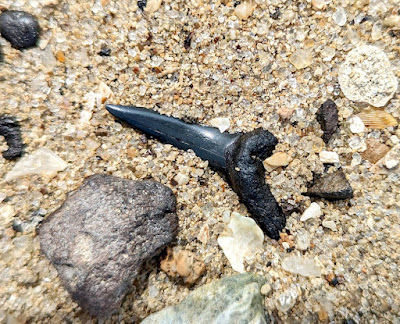Now that I am in the field five days a week I should probably do this more than once a month! I've got tons of photos to share - all of these are finds made by our clients and by our staff. I'm slowly getting used to waking up before 6 many days in a row - on such days I generally take a pretty lengthy post-field nap in the afternoon. I'm also getting used to receiving considerably fewer emails, and having genuinely supportive coworkers. Coming from an academic setting and being tipped by clients is also very weird: as a professor in the post-covid (can we *really* say post?) world, you're used to having a relationship with students that, sadly, is frequently more authoritative and to some degree antagonistic - some form of 'sword of damocles' is often the only hope to get current students to actually do their work, and even then... I'm used to being put on the spot and criticized by students, occasionally yelled at - so actually being tipped is quite strange. Awesome, but strange.
For a month after my resignation I had no particular interest in doing anything scientific, but that's starting to fade and the research itch is coming back. It's good to know I survived the flames without being irretrievable burned.
A cluster of the barnacle Concavus - an uncertain species. The barnacles are some of the only published marine invertebrates from the Oligocene of South Carolina.
An isolated tooth of "Phoca debilis", originally proposed by Leidy as a fossil seal, but in actuality, the single rooted molar of a heterodont dolphin from the Oligo-Miocene.
A ton of fiddler crabs! Uca pugnax. They move away from you in a hypnotic motion, and I realized that I had never gotten decent photographs of them. So, I charged them really fast and got this photo of a stampede of crabs at the edge of the sand. I apologize to the 10,000 crabs I almost gave little crab heart attacks to.
A nice ?squalodelphinid or possibly platanistid dolphin periotic - more careful comparisons are needed, but this specimen is a duplicate of one I found out on the harbor a few years ago. Most closely resembles "Phocageneus" from the Lee Creek Mine and Pomatodelphis. Specimens like this tell me that there are fossils likely derived from the Miocene out here.I got greedy after finding that periotic and strayed further down towards a gravel line closer to the low tide line, and earned myself a couple of pluff mud 'socks'.
A large tooth of the extinct sand tiger shark Carcharias cuspidata.
A medium sized channeled whelk (Busycotypus canaliculatus) shell - I did not keep this one because it was already claimed by a large thinstripe hermit crab (Clibanarius vittatus), our second-largest hermit here on the Carolina coast.
A fantastic little coprolite with some convoluted folding! I assume this is from some kind of bony fish.
The smaller of our two Oligocene barnacles - Amphibalanus halosydne - with its distinctive three ridges per plate.
Not a fossil, but a molar of a modern cow. Occasionally cow bones are found in the marsh... I can imagine the cow getting stuck in the mud at low tide and you can imagine the rest.
A tooth and dentary (or maxilla?) fragment from an even more monstrous fish - Conosaurus/Conosaurops bowmani. This species was originally named by Gibbes in 1851 from deposits along the Ashley River - likely the Ashley Formation or perhaps Chandler Bridge Formation. Gibbes originally thought this thing was a mosasaur lineage that had survived into the Cenozoic - Leidy later correctly identified it as a fish. We still don't really know what kind of fish it is: back in the 1950s, Rapp referred it to the Pachyrhizodontidae, which is an extinct group of mostly Cretaceous fish such as Pachyrhizodus. The teeth bear some resemblance to halibut, and I wonder if it's not some monster, big-toothed halibut or something a little more 'Cenozoic'.
A median tooth of a juvenile devil ray, Plinthicus stenodon. This specimen was only about 5 mm wide (check the sand grains!) and I dropped it on the beach and five of us could not relocate it. That's okay, we'll find another. This one was just exceptionally small; adult median teeth can get up to about 3-3.5 cm wide. They're wonderfully sculpted and resemble a comb.
A tooth of the extinct tiger shark Galeocerdo aduncas - now interpreted as a lower tooth of this species, formerly assigned to Physogaleus contortus.
Sometimes at high tide we can find teeth by just sifting the gravel with our hands - these two tiny teeth were in the same handful. Both are reef sharks, Carcharhinus spp.
Some kind of irregular echinoid (sea biscuit) - possibly something like Agassizia mossomi or Maretia carolinensis judging from Kier's paper on Oligocene echinoids from North Carolina. These are not very common and this one, albeit slightly crushed, is one of the more complete specimens we've seen out of the Ashley Formation.
A lateral tooth of the megatoothed shark Carcharocles angustidens. I initially thought this tooth belonged to a Parotodus.
A nice "beak" of a barnacle, a plate called the scutum - this was identified by Zullo et al. 1991 as Arcoscalpellum sp. - a gooseneck barnacle! I had *no* idea that these large scuta were from gooseneck barnacles. I need to save some examples now!
A partial tooth of Carcharocles angustidens, the Oligocene member of the otodontid lineage leading to C. megalodon.
An ancestral great white tooth - or possibly great white proper - Carcharodon hastalis or carcharias.
































